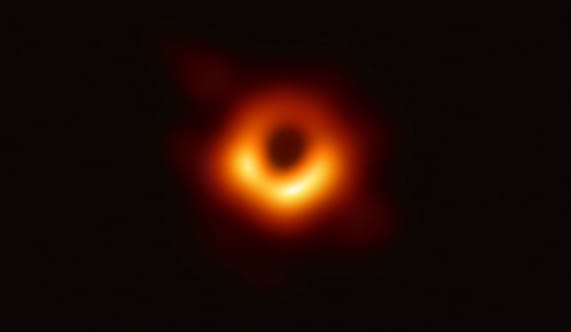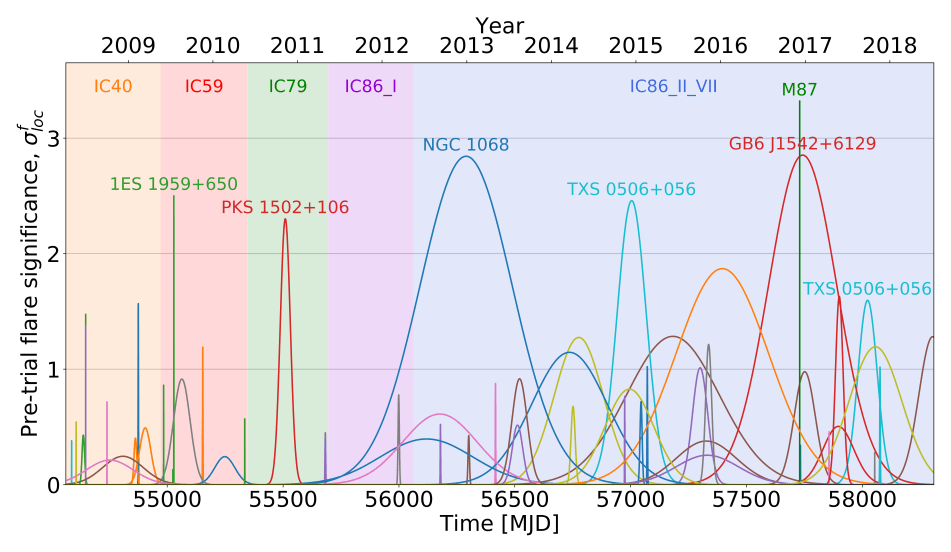The IceCube Neutrino Observatory, a peculiar telescope located in the ice of the South Pole, was built to detect mysterious particles called neutrinos that come from outer space. To pinpoint their cosmic sources, IceCube researchers look for unexpected excesses of neutrinos coming from localized directions in the sky.
In a paper published in 2020, IceCube searched a catalog of 110 intense gamma ray sources and found four interesting objects that were associated with evidence of a cumulative neutrino excess; that analysis focused on steady neutrino emission, therefore ignoring the times of the neutrino events. The IceCube Collaboration planned to analyze the time data in another complementary analysis using the same catalog.
The results of this “time-dependent” catalog search are outlined in a paper published last week in Astrophysical Journal Letters. The IceCube Collaboration conducted two time-dependent searches looking for neutrino flaring emissions from the same catalog of 110 sources using 10 years of IceCube data taken between 2008 and 2018. The collaboration found that the black hole at the center of a galaxy called M87 showed a moderate excess in neutrino emission, and they confirmed two flares previously observed from blazar TXS 0506+056.

For this work, researchers conducted a point-source search, which looked for the most significant time-dependent source in the catalog by combining space, energy, and time information of the events, as well as a test that looked for a cumulative time-dependent neutrino excess from a subset of sources.
Researchers already knew that TXS 0506+056, a neutrino-producing blazar and a source in the catalog, showed a significant time structure with two neutrino emissions: one short and low-energy, one longer lasting and with higher energy. This search analyzed an additional year of data for TXS 0506+056 and considered the time-dependent neutrino emission of all the sources in the catalog. In addition to TXS 0506+056, they were particularly interested in three sources—NGC 1068, PKS 1424+240, and GB6 J1542+6129—that exhibited the highest excess in the 2020 search. That previous search found NGC 1068, which is very close to the spot with the largest neutrino excess in the northern sky, to be the most significant source in the catalog.
“By looking at an additional variable in the neutrino emission—time—this analysis can identify different signal-like sources than what was observed by the time-integrated analysis,” says Francesco Lucarelli, a student at the University of Geneva in Switzerland and a lead on the analysis.
And another signal-like source is just what they found: The search revealed a seeming excess in neutrino emission from the black hole at the center of a galaxy called M87 that was not observed by the previous time-integrated analysis. (This black hole gained recent fame for being the first to be imaged.) Three events from M87 were detected in nearly four minutes at a level of 1.7 sigma. “If it is not a statistical fluctuation, it is puzzling, because M87 is one of the most beautiful accelerators of a few billion solar masses that is close to Earth,” says Teresa Montaruli, adviser to Lucarelli at the University of Geneva. “The short duration variability at day-scale from M87 has been recently observed also by gamma-ray experiments from the ground. Additionally, from other blazars, minute-scale variability has also been observed, potentially from knots in the jets of these powerful engines.”
One of the most intriguing sources in the catalog, NGC 1068, did not show a significant time-dependent structure; its detected neutrino events are compatible with a steady emission.

For the second part of the analysis, researchers ran a test to look for a cumulative neutrino emission from a subset of sources in the catalog to possibly identify sources within the catalog that were not strong enough to emerge individually. The test confirmed the evidence of the neutrino excess that had already been observed by the time-integrated analysis, reporting a neutrino excess at the level of 3 sigma from four sources: M87, TXS 0506+056, GB6 J1542+6129, and NGC 1068.
Lucarelli says their results might trigger a multimessenger campaign to look for possible photon counterparts for the neutrino flares they identified. For instance, Montaruli says it would be promising to join efforts with the MAGIC telescopes and the Cherenkov Telescope Array’s first large-size telescope prototype on La Palma, one of the Canary Islands.
Collaborators will also use improvements of the analysis and additional data collected by the experiment in the last few years to further study the excess in M87 and determine whether it is a statistical fluctuation or if it comes from a real astrophysical signal.
+ info “Search for Multi-flare Neutrino Emissions in 10 yr of IceCube Data from a Catalog of Sources,” IceCube Collaboration: R. Abbasi et al., ApJL920 L45 (2021), iopscience.iop.org, arxiv.org/abs/2109.05818